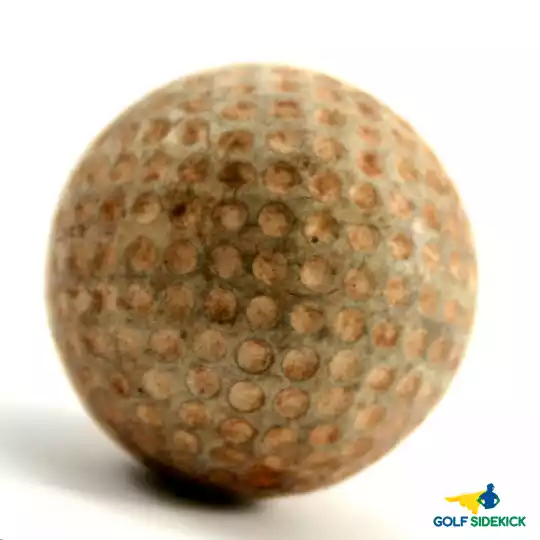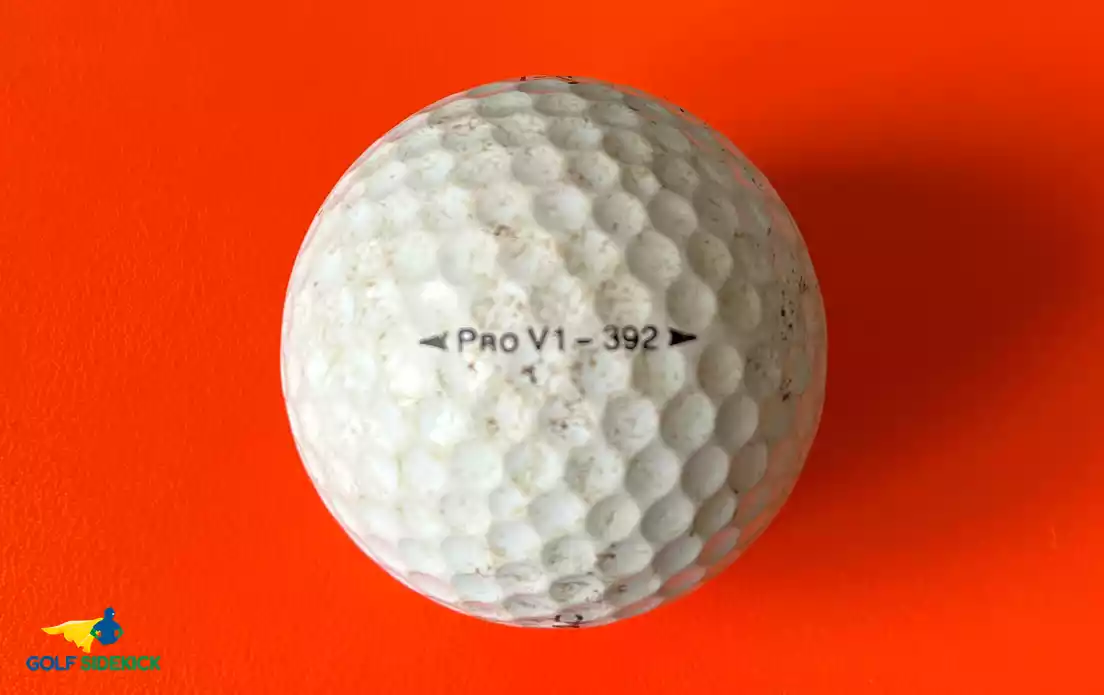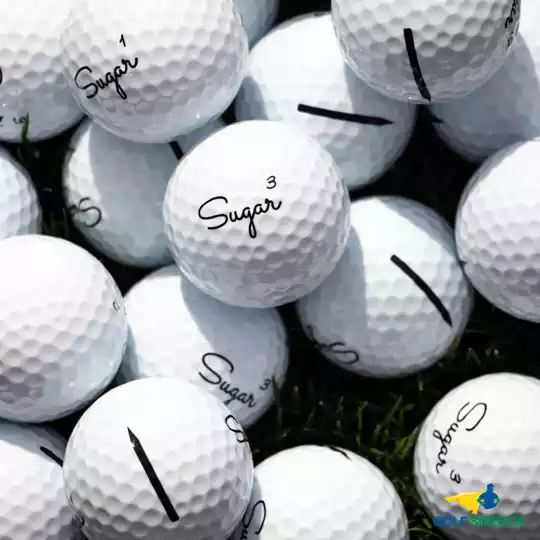Last Updated on December 26, 2023 by Matt Greene
In 1990, the USGA and R&A came together and agreed on the weight and diameter of the golf ball that is in use today. They agreed that a ball should have a minimum weight of 1.62 ounces and an inch diameter of 1.68. Golf ball size has remained the same for over 30 years.
Golf equipment manufacturers have made this the standard golf ball size, regardless of what type of measurement system is used in different countries.
But how did we get to this standardized ball? Some will know that the earliest golf balls used feathers, tree sap, and wood and that now the more modern two-piece and three-balls use man-made compounds like Urethane and rubber wound cores. Older golf balls, known as a British ball, can be found with a diameter less than 1.68 inches, as some golf balls, pre-1990s, had a width of 1.62 inches.
Let's go back in time and look at the history of golf ball size. We’ll take a look at how far the golf ball has come over hundreds of years to become the modern ball we all know.

The history of Golf Ball Size (British Ball to American Ball)
British Golf Ball - The Original
At the dawn of golf in England and Scotland, players used hard wooden golf balls usually on links golf courses. The firm wooden balls were difficult to control, and golfers switched over to what was known as the featherie in the 18th century. This new golf ball was far softer than the wooden golf ball, because they had feathers inside them, covered with a leather exterior. They were, however, too costly to produce. Imagine losing two or three of them a round!
The featherie was also not always round so when players hit the ball, knowing the ball flight was a lottery.
The new ball that players used was made with materials extracted from a former British territory in Malaysia. This ball was called the "Guttie" made from the dry sap of the Malaysian sapodilla tree. This ball was easy to make in quantity, could be reshaped when damaged, and cost much less than any prior version of the featherie ball.
American Golf Ball - Closer to today's ball
Once the guttie was the standard issue ball in England, a man from Cleveland, Ohio, created a new ball no one had ever seen before, turning the market on its head. This ball gave birth to the modern golf ball we are used to today. It was made with rubber threads almost like elastic bands, around a rubber ball shaped core.
That round core of rubber was covered with a material which was still used into the late 90s and early 2000s - balata. Material for the ball started coming from Central and South America and the Malaysian sapodilla was abandoned. Balata covers are made of balata sap, from the balata tree found growing in Central and South America.
The balata outer layer was soft and created backspin. In fact, if you haven't hit a balata covered golf ball, you have to try find some on eBay and give them a whack to see how much they spin. Dimples were finally introduced because of the malleability of the new cover which is the key to a predictable ball flight flight. Without dimples, the ball squirrels all over the place. The springy nature of the core of this new American golf ball increased distances the ball could be hit.
Balata balls were the golf standard for Tour quality golf balls even up to the Professional 90 and 100, as well as the Tour Balata golf balls by Titleist. Surlyn however, became a very popular material and is found surrounding most 2-piece golf balls currently on the market. It's a compound of a few materials and is much more durable than balata. Balata balls are known to split or deform, showing pimples on parts of the golf ball that strike hard surfaces. The rubber surrounding the core would snap and create a pimple on the cover.
Surlyn lowered spin rates and also lasted much longer, providing a straighter ball flight on a ball that could be used for many rounds. A balata ball would need to be replaced every few holes. Now everyday golfers had a more economical and fun ball to play.
Key Differences Between the British and American Golf Balls
The American ball, by USGA (United States Golf Association) Rules, must reach a diameter of 1.680 inches and not exceed 1.620 ounces, or 45.93 grams. Until the 1990s, the British governing body, the R&A, allowed the standard use of golf balls less than a diameter of 1.68 inches. These smaller golf balls were nicknamed the “British ball” by professional and amateur golfers.
Standard Golf Ball Size Today - The Rules
What is the diameter of a golf ball - and the weight?
A USGA-legal golf ball must have a diameter of 1.68 inches or 42.67 mm. Its weight must be a maximum of 1.62 oz. or 45.93 grams. These standards have been set by the USGA for America and by the British R&A, that governs golf in Great Britain and Northern Ireland and beyond.
A golf ball found to be heavier or larger than these standard diameters or weights is considered against the rules by the USGA and R&A, and golfers playing these balls will be disqualified from tournament competitions.
There are numerous golf balls on the market which game the system. They are of course not allowed in competition, but the general rule is that if the ball has a smaller diameter, it will go further. I have a few golf balls from a company called Zeus Impact and the golf balls are marked as 'non-conforming' on the pack so you know they are too small and against the rules.
In 1952, there were two sizes of the ball standardized: the smaller British ball had to be bigger than 1.62 inches in diameter and weigh less than 1.62 ounces whereas the larger American ball was to be no less than 1.68 inches in diameter and had to also weight less than 1.62 ounces. The difference is small, but the smaller golf ball flew farther and straighter than the larger ball. American players who went to play in the British Opens would change to the small golf ball during those tournaments because of the advantage.
In September 1970 both sides of the ocean tried to find consensus to use a 1.66-inch diameter golf ball. After 3 years of talking and negotiating and arguing, the idea was withdrawn in 1973.
In 1974, The R&A made the 1.68-inch ball mandatory at their Open Championship. The Royal and Ancient only outlawed the smaller golf ball in 1990. All this arguing over the size of a golf ball. Madness.
Dimples
There is no standard when it comes to the number of dimples on the surface of a golf ball. Equipment manufacturers can implement technology to create as many dimples as they want, although the small size of the golf ball prevents more than around 500 at most. The famous Titleist Pro V1 golf ball has 392 dimples.

Old Titleist Pro V1 golf ball with 392 dimples.
Differences Between two Piece, three Piece, and Multi-Layer Golf Balls
Two-Piece Golf Ball
Two-piece golf balls are 42.67 mm in weight and 1.68 inches in diameter. They consist of an outer cover layer usually made from Surlyn, and a smaller interior consisting of one solid core made from a plastic compound.
These two-piece golf balls offer more distance because they are usually harder than other balls, providing better compression for players with slower swing speeds. The 2-piece golf ball is the most common ball found on the market for average golfers. It's cheap and durable so they last very long, as long as you don't lose them.
Three-Piece Golf Ball
Three-piece golf balls have the same standard 1.68 inch and 42.67 mm width, and the same weight at a maximum of 1.62 oz. These balls have three parts; the cover, the small inner core, and a third layer between the cover and core. It sounds complicated but it's not - the core and 2nd layer are basically the same item just defined by different densities and colors.
The cover is almost always a urethane cover on a 3-piece golf ball. There are surlyn golf balls with more than one inner core but generally, you find the 3-piece is used by golfers who want more spin performance so they have a urethane cover.
Three-piece balls are becoming more and more affordable for players, providing enhanced levels of control and spin for golfers of all standards. The price of manufacturing a Titleist Pro V1 which is the most expensive ball on the market is ridiculously cheap - something like 10c.
Multi-Layer Golf Ball
A multi-layer ball offers more options for skilled players. These balls combine softness, spin control, and exceptional distance while adhering to the minimum rules on size and weight. Like 2 and 3 piece balls, these golf balls offer the same diameter, 1.68 in. or 42.67 mm and heft, 45.93 grams or 1.62 oz.
The ball has several smaller inner layers that surround a smaller core. The way these layers interact with the club face when the ball is struck can produce unique ball flight characteristics which are needed by better players. Professional golfers like Rory McIlroy, Tiger Woods and Bryson Dechambeau all use Multi-layer golf balls. Imagine how good the old greats like Arnold Palmer and Jack Nicklaus might have been with this technology available to them.

Questions and answers on golf ball size
Are all golf balls the same size?
Yes, for tournament play, the golf ball has a universal standard that must reach 1.68 inches, or 42.67 mm, in diameter, and a weight of no more than 1.62 ounces, or 45.93 grams.
This weight and diameter of golf balls is optimized for golfers to provide the most ball velocity and distance possible, along with a controllable spin rate. The diameter of modern golf balls is designed to work well with the size of the cup or hole on courses at 4.25 inches.
There are however quite a lot of manufacturers, especially in Asia that produce non-conforming golf balls. These golf balls are smaller, so they fly straight and further. The balls I have used are made by Kasco, called Zeus Impact. They must have had fun naming that golf ball.
Then there are other manufacturers like Callaway who make the SuperSoft MAX golf ball which are slightly bigger than the standardized golf ball. It's a mere 3-4% larger but it's supposed to promote distance and control.
When did the golf ball change size?
The golf ball has changed sizes multiple times over its history, but the standard of 1.68 in. and no more than 1.62 oz., were set as the minimum measurements in 1990. The R&A wanted the British ball to stay at 1.62 inches in diameter for their own rules of golf.
As the game increased in popularity in the USA, the size became universal after a compromise Manufacturers soon adopted the technology to create these golf balls to this size for the open market, so amateurs could play with the same ball as the pros.
What is the size of a golf ball in centimeters and mm?
The golf ball size in centimeters is 4.268 cm or 42.67 mm in diameter. For playing equipment, this standard is equivalent to 1.680 inches, as every golf ball must meet that minimum to be legal to play in tournaments.
The size of these golf balls, as approved by the rules of golf authored by the United States Golf Association, or USGA, is uniform because this specific weight and diameter provide the best velocity and distance for all playing conditions.
Golf ball weight
For a golf ball to be legal it must have a weight of no more than 1.62 ounces, or 45.93 grams.
Why is a golf hole 4.25 inches?
In 1891, the British R&A rules governing body established the 4.25-inch diameter for a golf hole. Before installing these regulations, the size of the hole was larger, up to six inches in depth in some instances. The hole is this size to make the game difficult yet possible to hole out from a distance.
Anyone arguing that the hole is too small will have a tough time. The point of golf is for people like us to try something difficult and overcome the difficulty with the hope of those perfect shots that go in the hole. Golf has been going strong for years and years with the 4.25 inch cup so it won't stop now.
There has been chatter about making the hole bigger for weekend players and casual golfers. Some courses will cut bigger holes for some fun tournaments. There is also a game called golf soccer where the holes are cut big enough to contain several soccer balls. The question you have to ask is, will a bigger hole actually make people score lower?
There is no real talk about changing the 4.25-inches for professional golf by either of the two governing bodies.
What is the volume of a golf ball?
Because the USGA and R&A allow a ball to have a diameter of 1.68 inches, when you calculate the volume of a ball, the answer of the volume of a golf ball is 2.48 cubic inches or 40.68 cm3. The number of dimples and how deep they are can also reduce that volume though.
Circumference of a golf ball
The circumference of a standard golf ball is approximately 68 millimeters (2.68 inches) as per the regulations set by the United States Golf Association (USGA). However, there can be slight variations in the exact size of a golf ball produced by different manufacturers.
Golf ball size in cm
The size of a standard golf ball is approximately 4.27 centimeters (or 42.7 millimeters) in diameter, as per the regulations set by the United States Golf Association (USGA). The circumference of the golf ball, which is the distance around the ball, is approximately 13.42 centimeters (or 134.2 millimeters).
Golf ball size in mm
The size of a standard golf ball is approximately 42.7 millimeters (or 4.27 centimeters) in diameter, as per the regulations set by the United States Golf Association (USGA).
Final Thoughts on Golf Balls Size
The golf ball is a confusing thing so we hope to clear the info up for you through our lists of golf balls and explanations in further detail about the nature of the balls, how they react to being hit, how they react to landing. The golf ball is such a talked-about topic and knowing some history about it can help you understand just how good we have it nowadays in terms of costs and benefits of the golf ball.
It's standard for everyone now and we can play anywhere under the same regulations on the ball.
